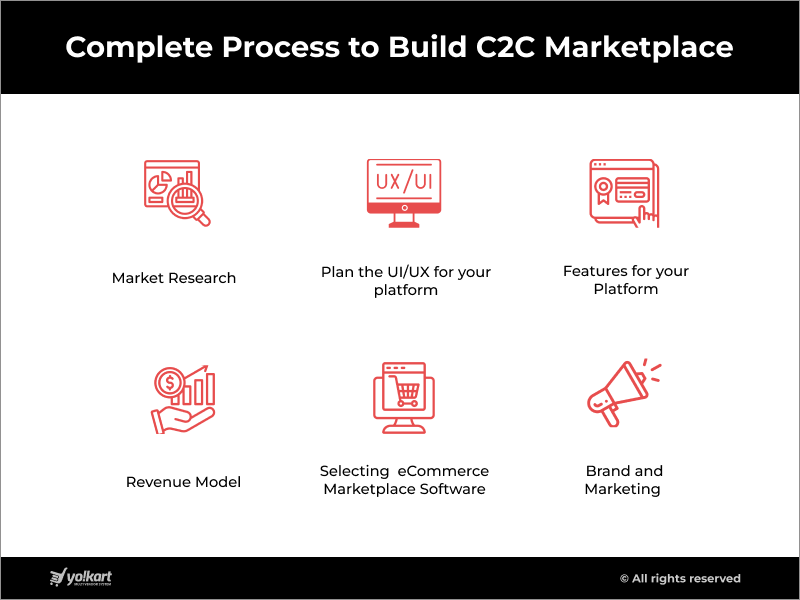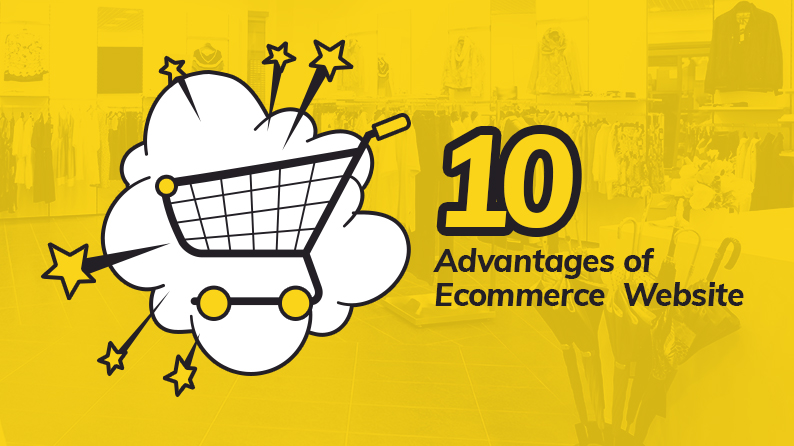Updated On: 25th June 2024
The C2C model in eCommerce empowers users to switch between buying, selling, or doing both. When compared to B2C or B2B, it’s an ecosystem that emphasizes interactions between users, opening up multiple use cases where an online marketplace platform acts as an intermediary and facilitates online commerce between these users.
Although C2C has been around since the likes of eBay (est. 1995), it’s in the last few years, that it’s been increasingly leveraged across industries. Bolstered by recent trends such as recommerce, increased capabilities of web/mobile apps, and a generational shift towards finding creative monetization opportunities ― the C2C model in eCommerce is an evolutionary progression of retail, in the contemporary era. The future looks even brighter as eCommerce businesses look to explore more ways to leverage C2C models.
But should you look to build a C2C eCommerce marketplace? If yes, how? Read this blog to get all your questions answered. By the end of this article, you will have an in-depth analysis of Why and How to build a C2C marketplace in 2024.
Table Of Contents
Benefits of Running a C2C eCommerce Marketplace
So if you are asking yourself: C2C model in eCommerce, Is it for me? To get an answer around that, first learn the benefits/advantages it offers. Based on this, you will have an analysis of the fundamental drivers that pillar this type of eCommerce business. This can help you if you want to evaluate this decision, or in a certain scenario, you might just want to tweak an existing B2C eCommerce idea. Read below to find the benefits of starting a C2C marketplace.
No Inventory/Warehousing Hassle
While multivendor eCommerce, (or an online website that has multiple sellers), does not require the intermediary to own an inventory, some B2C marketplaces do start with an inventory. This is done to get that initial traction when you don’t have any sellers onboard. For instance, Amazon started by selling an inventory of books.
In a C2C eCommerce marketplace, even that is not required. The commerce takes place between users, so the intermediary marketplace does not need to have any inventory. Similarly, there is also no need for physical warehouses to stock any fulfillment orders.
Lower investment requirements and lower overheads
Just like you won’t need warehouses, there are other advantages that makes a C2C marketplace asset-light. For a start, you need to make lower investment upfront. Then the requirement for physical assets like offices is lesser. (By following the right process, a C2C marketplace can practically be started from your garage.) As an intermediary, there might be a lesser need for staff. Moreover, marketing too requires lesser costs. While this means that initial investment is lower, this also implies that the running cost of the business is lower as well.
However, this can be subjective, and may not be true for all C2C eCommerce marketplaces. Some offer pick-up and drop-off services for the products. This means that the involvement of the business as an intermediary is more than a typical eBay-like C2C business.
Easier Seller Acquisition
If you were to ask any eCommerce marketplace startup entrepreneur, one of the biggest challenges is to find a way around the chicken-egg problem of eCommerce marketplaces i.e. who do you reach first: the buyers or the sellers? Without sellers, there will be no buyers, and vice versa.
C2C model in eCommerce is a tailormade hack for this paradox ― reach out to both simultaneously. Since the buyers can be sellers and vice-versa, you are effectively reaching out to the same set of users.
Leverage Latest Trends with C2C marketplace
Let’s discuss something we touched upon at the beginning of this article. How C2C is catching the pulse of the market ― and leveraging commerce between users to encash on the latest trends:
- Recommerce: Simply put, it is the trend where customers sell used products to other interested consumers. Apart from giving consumers products at a lower price point, this also caters to gaining concerns of sustainability and recycling.
- Building a community: Contemporary C2C eCommerce marketplaces like Vinted and Taobao have successfully built a community around their platform. This further engages its target audience, gains their loyalty, and helps the business to gain a stronghold in the market.
- Engaging the new generation user: Independent, tech-driven, and social media savvy, Gen Z is more proactive with creating income streams than any of their previous generations. According to The Economist, Gen Z is experiencing the highest “young person premium. Interestingly, C2C marketplaces give these newer generations innovative side hustle opportunities.
Top 5 C2C eCommerce Marketplace Examples
By now you know some of the typical benefits of a C2C marketplace, let’s get to know some popular platforms that have leveraged these benefits to build their brand. Read about the top C2C eCommerce platforms below:
1. eBay
eBay is a well-known C2C platform that allows consumers to sell to other consumers online. It was one of the pioneers of the C2C model in eCommerce. From automobile accessories to fashion to electronics, the platform allows its users to post products under multiple product categories. eBay earns revenue by charging sellers for connecting them with potential buyers.
Buyers have several payment options, including credit card, PayPal, or bank debit, which is one of the reasons sellers choose eBay over other sites. The seller then uses eBay’s shipping software to generate labels and ships the package using one of the three major carriers eBay has partnered with – USPS, UPS, or FedEx.
2. Etsy
If eBay can be credited for introducing the C2C model in the eCommerce industry, Etsy pioneered the concept of a C2C marketplace for a specific niche. A brand that is now well-known for handicrafts and unique items, Etsy differentiated its business by addressing key pain points of its target audience. Some of these include an intuitive selling process, that makes it easier for first-time sellers to register and sell. Also, low commission rates add further value. The fundamental driver, however, is a sense of community and focus that Etsy brings to the table for its users. Currently, Etsy has a GMS of $3.6 bn and a user base of 96 million from across the world.
3. Poshmark
What Etsy has done for handicraft C2C users, Poshmark has done it for fashion C2C users ― Poshmark is a C2C marketplace like Etsy, but it operates exclusively in the fashion industry. And just like the former, Poshmark too has tailored its platform to its target audience. For instance, it has a higher selling fee, but the applicable slabs are flat. Similarly, listing on the platform is free, and seamless. All these differences ease complexities for users and allow them to post multiple products easily. Ease of use and capabilities to post multiple products are pivotal drivers in fashion C2C. These are some of the ways Poshmark has been able to stand out for its target audience, positioning its brand as a popular C2C marketplace platform.
4. Vinted
This Fashion C2C platform started operations in Lithuania, gradually spreading across the continent of Europe. The platform operates in the fashion niche and also caters to the luxury fashion product categories. Vinted started operations in 2008, registering as the country’s first unicorn in 2019, reaching a current valuation of US $3.7 bn.
While Vinted is a C2C marketplace like eBay, and operates on a similar business model, it also differs in several ways. For instance, it has a ban on readymade product photos like those from the store or the product’s brand pages. The platform allows only authentic user-generated photos. These measures ensure that the platform discourages professional resellers, and stays true to its C2C ethos.
5. TaoBao
Owned by Alibaba, TaoBao is a China-based C2C eCommerce marketplace. It acts as a platform within China ― and as a window to the rest of the world as well. TaoBao differs from the rest of the C2C platforms in the sense that its policies do not restrict professional resellers and smaller businesses. However, the platform does support typical C2C operations. Also, just like the others, the brand has worked on fostering a loyal community around its platform. Features like direct buyer-seller communication channels, microstore capabilities, well-designed mobile apps, and more. The C2C marketplace has about 612 million active users in China alone. Overall, it is the eighth largest of all global eCommerce platforms.
Ready to Join the Race of These Successful C2C Marketplaces?
Complete Process to Build C2C Marketplace
The success of these C2C eCommerce marketplaces inspires aspiring entrepreneurs and if you are one of them, the below-mentioned information is going to help you. Building a C2C marketplace like eBay or Vinted requires a deep understanding of the target audience and their needs, as well as a clear vision for the platform’s functionality and design.
Let’s see how to build C2C marketplace.

1. Market Research
When building a C2C marketplace platform, the first step is to determine the type of marketplace you want to create, for whom to create, and what should be included in the platform. Here everything would start with first identifying the target audience and understanding their needs. For instance, when the founders of Etsy worked with web developers with a specific user base, they came across several pain points. With that the idea to start their eCommerce business took shape, and the rest is history.
Another important consideration here is a competitive analysis. For instance, in the example shared above, the users were using eBay before Etsy was launched. However, eBay wasn’t able to provide a solution to their pain points. Moreover, the commissions were higher. Etsy in its strategy, catered to these pain points. Likewise, your competitive research will be the backbone of your business idea to start.
2. Plan the UI/UX (Front-End) of your platform
The visual design of your site plays a significant role in a user’s initial evaluation and impression. To ensure that your design effectively captures the user’s attention, it’s important to focus on elements such as layout, typography, images, and consistency.
The design should align with the purpose of the site. To create a design that is effective, simplicity is key. Along with appearance, it’s also crucial to ensure that users can easily find what they are searching for or complete desired actions with ease. In line with the principle of simplicity, the next important aspect of the design is visual hierarchy.
This involves arranging website elements in a way that guides visitors to the most important elements first. A Z-Pattern design follows the natural path of a reader’s eye movement, from left to right, top to bottom. The pattern starts at the top left corner and moves to the top right, then down the left side, and finally back to the right side. This pattern encompasses all four crucial elements of effective design: branding, call-to-action, structure, and hierarchy.
3. Identify Essential Features for your Platform
Incorporating eCommerce features that give your buyers a shopping experience they want to come back for; sellers an easy shopping experience; and finally you with the tools to execute your business strategy will be key to your success. Let’s see which features will be key in C2C eCommerce success.
Features pivotal for users (buyers and sellers):
- Easy Log-in: From the user’s perspective, the sign-up process can be a roadblock to their desired activities on the eCommerce platform. Expedite this process by creating an easy sign-up experience.
- Search & Filters: Empower your customers by providing them with a filtering option that allows them to be more specific about their preferences and hides products that are not their priority. This makes the search process more efficient and helps to improve their overall experience on your C2C marketplace.
- Easy-to-use product listing feature: While detailed product listing is key to all eCommerce, the simplicity of use is equally integral to C2C operations. Your users need to have an intuitive and capable product listing feature at their disposal.
- Buyer-Seller Communication: Implement communication channels that enable sellers to communicate with their buyers. Because a strong community is key to C2C interaction, such a communication channel is an important facet. Moreover, it also reduces the likelihood of order cancellations and returns.
- Dedicated Account Management: Provide the buyers and sellers with a personal user panel that offers complete information about their transactions on the C2C platform. Moreover, this would assist them to plan and personalize their activities on the platform.
- Request For Quote: If you are planning to build a C2C marketplace like eBay or Vinted, which can have products with flexible pricing, you should consider adding a “Make an Offer” button alongside product pricing. This enables the buyers to quote a price of the product to the sellers, enabling negotiations.
Start your C2C Marketplace with RFQ for price negotiations
- Product Listing Control: Provide the ability for the admin to oversee and manage the products uploaded by sellers, including the removal of any illegal or prohibited items. This helps to maintain the integrity and compliance of the C2C marketplace.
- Marketing & Promotion: The admin can boost the marketplace’s visibility by utilizing the integrated modules, leading to an increase in website traffic and an improved conversion rate.
- Reports & Analytics: Effective decision-making hinges on data. Give the Admin pivotal data insights with detailed reports and analytics.
- Content Management: The admin can effortlessly manage the content and make timely changes to align with the current market trends and demands.
4. Choose a Revenue Model
The selection of a revenue model is contingent upon the needs and objectives of your business. Nonetheless, the following are the commonly employed models by C2C marketplace businesses.
- Commission Model: Commission fees are another widely used revenue model in marketplace businesses. This model involves charging a fee for every transaction made on the platform, which can be collected from either the end customer, the seller, or both. This revenue model is highly effective as it generates revenue with every transaction.
- Listing Fee: The listing fee model involves charging users for every product/service they list on the platform. Listing fees are typically lower and more affordable than subscription fees, but this also means that earning a significant amount of revenue can be more challenging. As such, it may be a good idea to use this model as a secondary Revenue Stream.
- Subscription Model: The subscription fee model entails charging marketplace users a recurring charge for accessing the marketplace. This approach offers the advantage of predictability in terms of monthly revenue and has the potential to draw more users to platform.
- Monetizing Advertisements: Website banners and other real estate can be utilized to post sellers’ ads, in exchange for a fee.
To achieve optimal results, it is advisable not to limit yourself to one specific revenue model and instead consider combining multiple revenue streams.
5. Selecting the Right C2C eCommerce Marketplace Software
Some years back, you had to hire a team to code the entire website from scratch, test each aspect, deploy it, and wait for customer feedback. A highly resource-intensive task, that took hundreds/thousands of development hours, delaying your go-to-market strategy. Also, you have to pay for all these hours of development on a per hour basis, leading to the cost to develop jumping up significantly.
In the current day and age, you have the option of capable C2C eCommerce solutions. These help you to build a C2C e-marketplace website without unnecessarily coding the entire website. Only certain scenarios like integrating an enterprise’s legacy IT infrastructure, or any other particular requirements need a longer development process. Otherwise, it’s about choosing the right turnkey eCommerce solution.
It can be a challenging task to find the perfect C2C marketplace software with all the choices available, but if you evaluate the requirements of a C2C marketplace, then choose along these lines:Consider factors such as scalability, payment options, integrations, right C2C features,customer support, and costs. By considering these factors, you can select a C2C eCommerce software.
6. Strategize for your brand and marketing
After your C2C eCommerce platform has been deployed on the server, focus on the next step i.e. branding and marketing. A strong and lasting relationship with customers is crucial, especially in a highly competitive environment. To achieve this, it’s important to prioritize trust. This will allow customers to become advocates for your business, leading to increased brand visibility, attracting more customers, and ultimately boosting revenue. And to build trust, an effective brand strategy is pivotal.
To build your brand strategy, focus on understanding the value of your business. Convey this value via a simple to understand and relatable brand message. Base your marketing strategy on this message ― engage with your audience through authentic storytelling, leverage social media platforms for targeted advertising, implement SEO strategies to drive organic traffic, and leverage tools like email marketing to foster customer relationships.
Yo!Kart – Best C2C Marketplace Solution
Yo!Kart is an all-inclusive multi-vendor solution that has a customizable design, purpose-built C2C features, and robust technology, With Yo!Kart, business owners can easily create, launch, and scale their C2C platform. It provides entrepreneurs with the opportunity to start their marketplace with just a one-time-investment. Further, Yo!Kart offers the following:
- Capability to support C2C eCommerce model in multiple niches.
- A range of C2C eCommerce focused features.
- Easy to use, simplified user interface with a conversion focused system.
- Secure and versatile system with pre-integrated business APIs and 20+ payment gateways.
Book A Personalized Demo To See Yo!Kart In Action
Closing Thoughts
In conclusion, building a C2C eCommerce marketplace is a complex process that requires careful planning and execution. This process can be simplified if you choose the right C2C eCommerce solution, and have a well defined go-to-market strategy and a well formed business plan. With a purpose-built eCommerce website and the right strategies in place you can set forth with a business model that is defining contemporary online retail.
FAQs
Q. What is a C2C marketplace?
Ans: C2C is short for Consumer to Consumer. So, an eCommerce marketplace that provides a platform for consumers to sell or/and buy. In other words, users can conveniently register as buyers or/and sellers on the platform.
For instance, Etsy is a C2C marketplace. Sellers on the marketplace use the platform to sell their products. Additionally, they also use the platform to source raw materials on the platform as a buyer. So the same user can be a seller or a buyer on Etsy.
Q. What are the key considerations to make a C2C business model work?
Ans: Let’s again take a look at Etsy’s example. The marketplace implemented the following business strategies to achieve success.
- Offer an intuitive and convenient marketplace platform that allows users who are not business owners to do business on the platform.
- Provide supportive features for ease of business.
- Give a low barrier of entry to sellers with low commission rates, and more.
- Build a community just like Etsy has right from the start.
- Build a full ecosystem keeping the target users in mind with value-added services, seller workshops, and more to empower and encourage seller onboarding.
- Lastly, but significantly, create your brand identity in a way that resonates with the target audience with effective marketing strategies.
Q. What are the benefits of a C2C marketplace platform business?
Ans: There are some key benefits of a C2C marketplace platform and they all centre around the fact it is relatively easier to gain traction with the users.
For a start, it’s relatively easier to solve the chicken-egg conundrum, as sellers and buyers can be targeted using cohesive marketing strategies, so onboarding both simultaneously is easier.
Furthermore, a C2C marketplace is easier to scale up, as the same users can perform dual roles of sellers and buyers. Also, in such an ecosystem, users can identify with their peers, catalyzing a community effect within the marketplace. This can potentially lead to more users signing up, and enhance user engagement opportunities. With the right features, this opportunity can be leveraged to gain platform success.
Q. How will I attract users to my C2C marketplace platform?
Ans: You can attract users on the platform by following Etsy’s template success.
- User-friendly, engaging, and intuitive platform.
- Domain-specific features.
- Low commission rates.
- Effective marketing strategies.
Q. How do I choose the best C2C marketplace software?
Ans: It is recommended you choose C2C marketplace software that allows you to build a best-suited platform for C2C users. Some key parameters are as follows:
- No-code marketplace builders, that will require no coding from your side.
- User-centric Solutions that are built to offer logical, and easier workflows for efficient and intuitive management.
- SEO-ready solution with multiple features to upsell, and cross-sell.
- API-driven versatile interface that allows you to leverage third-party eCommerce services seamlessly.
- Customizability and scalability – that gives long-term viability for the business.
- Affordable solutions that do not require recurring investments in the form of subscription fees, transactional, or any other charges that can prove to be an impediment in the long run. Furthermore, this will also help you to minimize business overheads and extend the benefit to the users in the form of lower commission charges.
These are some, but essential and detrimental features that can help you to implement a C2C marketplace platform with greater chances of success.
Q. How to build a C2C marketplace platform?
Ans: The following steps can be adopted to build a C2C marketplace platform
- Perform market research, competitor analysis, and identify buyer needs.
- Identify the best-suited features to implement the business plan.
- Choose between custom-development and readymade solutions.
- Start lean with essential features, also known as the “MVP approach”. Scale as move on in the business, as per the feedback received from the early adopters.
- Start with a purpose-driven marketing approach that allows you to create a distinct brand voice in the market.




